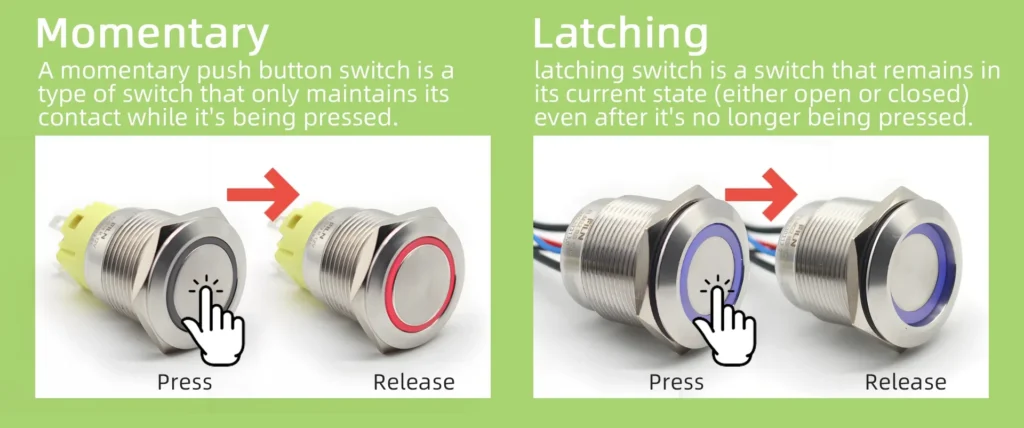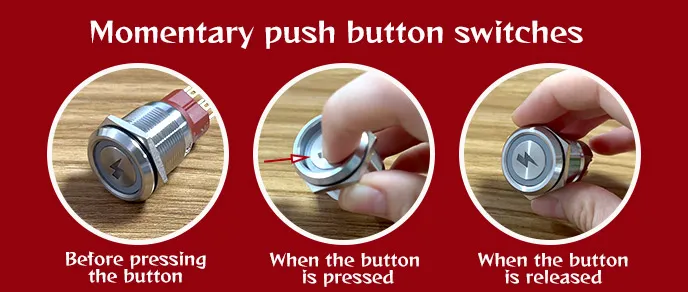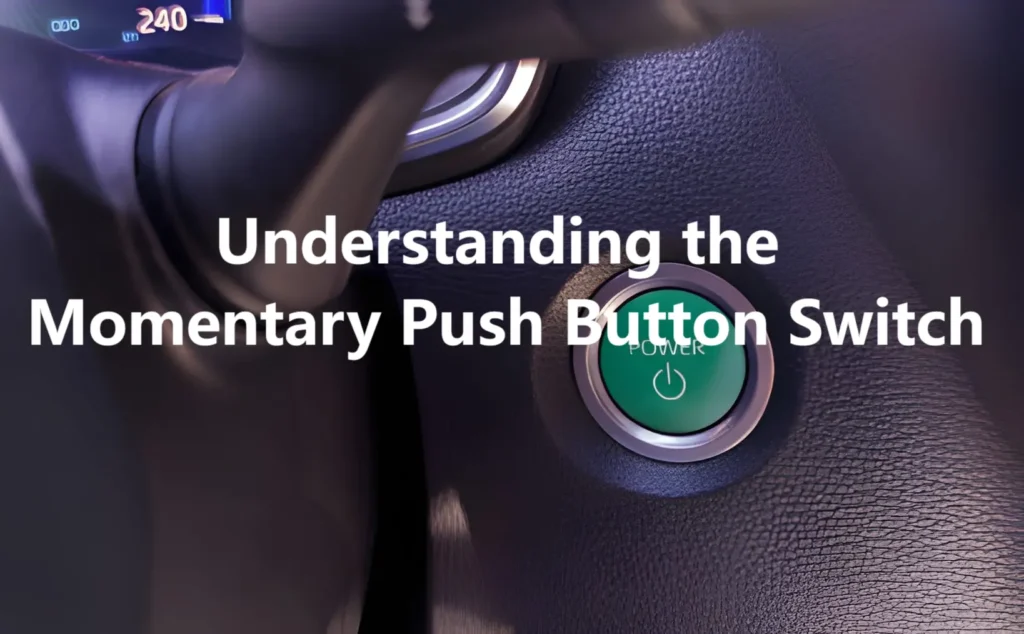A momentary push button switch is a crucial part of many electronic and mechanical devices. It only stays active while pressed, making it perfect for situations needing short-term operation. Also known as a temporary or non-latching switch, it is widely used in consumer gadgets, industrial equipment, vehicles, and more.
This article will cover what momentary push button switches are, their types, main features, and specifications. We will also discuss where they are commonly used, their benefits, how to install and maintain them, and offer a detailed buying guide. Our goal is to provide you with clear and practical information to help you choose and use these switches effectively.


What is a Momentary Push Button Switch?
A momentary push button switch is a device that remains active only while being pressed, automatically returning to its default position once released.
This feature, driven by an internal spring mechanism, sets it apart from latching switches which stay in their new state until pressed again.
Momentary switches work by completing or breaking an electrical circuit during the press, enabling temporary activation in devices like doorbells, keyboards, and control panels.
Key differences between momentary and latching push button switches include:
| Feature | Momentary Push Button Switch | Latching Push Button Switch |
|---|---|---|
| Definition | Active only while pressed | Maintains state until pressed again |
| Operation | Returns to default once released | Toggles state with each press |
| Common Uses | Doorbells, keyboards, control panels | Light switches, power switches, mode selectors |
| Circuit State | Temporary connection/disconnection | Maintains connection until next press |
| Energy Consumption | Uses power only when pressed | May consume power in both states |
| Design Complexity | Generally simpler | Often more complex |
| User Interaction | Requires continuous hold to stay active | Single press changes state |
| Typical Applications | Push-to-talk, start, reset buttons | On/off power and toggle switches |
| Mechanical Structure | Spring returns switch to default | Mechanical or electronic latch maintains state |
| Durability | Designed for high-frequency use | Varies with application and usage |
Momentary switches provide a temporary circuit connection, ideal for brief, on-demand activation. They typically feature a spring-loaded plunger that moves electrical contacts together while pressed, allowing current flow. Once released, the circuit opens, stopping current flow.
This mechanism ensures precise control and safety in numerous applications. Energy consumption is minimal, as power is used only during actuation. These switches tend to have a simpler design and are built for frequent use with a reliable spring return.
Types of Momentary Push Button Switches
Momentary push button switches come in several common types, each suited for specific functions:
- Normally Open (NO) Switches: These switches stay open (off) by default. When pressed, the circuit closes, allowing current to flow. They are often used in push-to-talk buttons, start buttons, and similar applications needing temporary activation.
- Normally Closed (NC) Switches: Opposite to NO, these switches remain closed (on) until pressed. Pressing opens the circuit, cutting off current. These are commonly found in safety and emergency stop systems where breaking the circuit quickly is critical.
- Double Throw (DT) Switches: These can connect to two different circuits and switch the connection from one to the other when pressed. They are useful in situations requiring toggling between two states, like alternating two lights.


Key Features and Specifications
When selecting a momentary push button switch, several key features and specifications are crucial to consider for optimal performance and durability:
- Material and Build Quality: Switches made from high-quality materials, like durable metals or robust plastics, ensure long-lasting use and reliability, especially in tough environments or heavy-duty applications.
- Electrical Ratings: It is important the switch’s voltage and current ratings align with your application’s requirements to avoid damage and maintain safe operation. Common ratings range widely depending on the device and industry.
- Environmental Resistance: For outdoor or harsh conditions, look for switches with waterproof and dustproof certifications, such as IP65, IP67, or higher. These ratings guarantee protection against moisture and debris that could impair operation.
- Actuation Force and Travel: The amount of force needed to press the switch and the distance the button travels impact user comfort and control precision. Lower actuation force enhances ease of use, while travel distance influences tactile feedback.
- Durability and Lifecycle: Check the expected mechanical and electrical life cycles, often measured in hundreds of thousands or millions of operations, particularly important if the switch will be frequently used.
Additional features like tactile feedback, illuminated versions for status indication, and soft-touch designs can influence user experience. Many momentary push button switches offer customization options to suit specific ergonomic and technical needs.
Applications
Momentary push button switches have a wide range of applications across industries due to their ability to provide quick, temporary activation:
- Consumer Electronics: These switches are found in devices such as calculators, remote controls, gaming controllers, and keyboards, where precise momentary input is essential.
- Équipement industriel : They are crucial in control panels, machinery start/stop buttons, and emergency stop systems, ensuring operational safety and quick response.
- Automotive: Common uses include horn buttons, dashboard controls, ignition systems, and electric window controls, where momentary action controls specific functions.
- Medical Devices: Momentary switches enable precise activation in diagnostic equipment, emergency signaling devices, and operating room controls.
- Home Automation Systems: They are integrated into smart home setups for controlling lighting, security features, and automation products, offering user-friendly temporary controls.
Additional specialized uses include elevator controls, burglar alarms, laser pointers, and wearable technology. The switches’ instant response, energy efficiency, and durability make them ideal for applications requiring frequent and reliable momentary input. Choosing the right switch depends on the specific needs of the device or system, including environmental conditions and electrical requirements.
Advantages of Using Momentary Push Button Switches
Momentary push button switches offer several key advantages that make them popular across many industries:
- Energy Efficiency: These switches consume power only during the brief moment they are pressed, reducing overall energy use and extending device battery life.
- Ease of Use and Simplicity: Their straightforward design allows for easy operation without complex mechanisms, making them user-friendly in many applications.
- Reliability and Longevity: Built with durable materials and designed for frequent use, these switches can withstand millions of presses without failing, ensuring consistent performance over time.
- Versatility: Available in numerous designs, sizes, and configurations, momentary switches can suit a wide variety of technical and ergonomic needs, from consumer electronics to industrial machines.
- Precise Control: The temporary connection ensures that devices only activate when intended, which enhances operational safety and reduces accidental activation risks.
- Compact and Space-Efficient: Many momentary push buttons are small and easily integrated into tight or portable spaces.
Installation and Maintenance Tips
Proper installation and maintenance are essential for the reliable performance of momentary push button switches. Here are key tips:
- Wiring and Connection: Identify switch pins (e.g., normally open, normally closed, common) accurately and securely connect wires to avoid loose contacts which can cause malfunctions. Use the manufacturer’s wiring diagram and ensure proper polarity, especially if the switch includes LEDs.
- Voltage and Current Compatibility: Match the switch’s voltage and current ratings with the device’s specifications to prevent overload and damage.
- Safety Precautions: Always turn off power before wiring to avoid electric shock or short circuits. Verify all connections before powering the circuit.
- Regular Inspection and Cleaning: Periodically check for dirt, dust, or corrosion around the switch and clean them carefully to maintain smooth operation.
- Troubleshooting: If a switch exhibits intermittent action or becomes stuck, inspect for physical debris or damaged contacts. Ensure the spring mechanism is functioning and replace the switch if needed.
Buying Guide
When buying a momentary push button switch, consider these important factors to make the best choice:
- Brand Reputation: Choose well-known brands with a track record of quality and reliability. Trusted manufacturers like ONPOW, FILN, APEM, EAO, and Eaton are recognized for their durable and precise switches.
- Specifications: Ensure the switch matches your application’s exact requirements, including voltage, current rating, size, environmental resistance (IP ratings), and actuation force.
- Popular Brands and Manufacturers: Research multiple brands and read user reviews to understand product performance and customer satisfaction. Leading brands often provide better after-sales support and warranty services.
- Price and Value for Money: Compare prices across suppliers but focus on the overall value considering durability, specifications, certifications (UL, CE), and customization options. Cheaper switches might be sufficient for simple projects, but industrial or critical applications require higher-quality components.
- Additional Factors: Consider whether you need illuminated buttons, customizable colors, or waterproof features. Also check installation ease and availability of technical support.


Don’t Miss Out on Premium Momentary Push Button Switches!
Get reliable, long-lasting switches with excellent features. Order now to boost your project’s success and benefit from our expert support.
Conclusion
Momentary push button switches are essential components widely used across many industries due to their temporary activation feature.
Their versatility, reliability, and ease of use make them suitable for applications ranging from consumer electronics and automotive systems to industrial machinery and home automation.
They provide precise, quick responses and energy-efficient operation, which enhances both user experience and device functionality.
Understanding the various types, specifications, and features of these switches helps in selecting the right product tailored to specific project needs.

